Stainless Steel & Glass Balustrade Inspiration
Posted by Greg Parkins on
Balustrades and handrails play a crucial part in landscape design, whether that be for safety or privacy purposes, or to transform a space.
There are numerous types of balustrades on the market, but a Stainless Steel and Glass Balustrade will accentuate a garden sectioning off areas from the rest of the garden. By choosing a glass balustrade, the area receives both a practical and stylish upgrade, without being intrusive to the space or blocking natural light.
There are several types available on the market, each with their own individual merits and style. Some of the most popular Stainless Steel and Glass Balustrades available are:
- Posts with glass infill
- Posts & Handrail with glass infill
- Posts & Handrail with Wire between
- Frameless glass - Channel type
- Frameless glass with handrail
- Glass Spigots
- Glass Clamps
Below are just a few ideas for inspiration from a popular and ever growing trend.
Simple designs for every season

This simple design speaks for itself. When it comes to zoning off an outside area that will be used for social occasions, a glass balustrade ensures that the sunlight can still reach the circumference of the space.
This is great for alfresco dining, barbeques or even winter nights as it allows the space to be intimate but private and secure too.
Modern and charming

If you are looking to give your garden a modern upgrade, a design like this will uplift the landscape with a contemporary feel. The glass panels add class, which doesn't just compliment the property, but also adds value too.
Our toughened safety glass is durable and strong, without compromising on the look. We can also create special shapes, holes & cut-outs with no problem.
We also supply laminated glass in a range of sizes.
Amplifying the height

For raised decking spaces, a balustrade is essential for safety. By adding a Glass Balustrade and Handrail it enables the space to act as a balcony, which maximises the view of the garden or landscape.
Consider the key features The handrail can also be decorated by embellishing the surface with lights of foliage.
We often get asked, "Do I need a handrail?" - a rule of thumb is that if you have a drop of 600mm or more, then a handrail to a height of 1100mm is required.
When using 10mm Toughened Glass between posts, advice should always be sought from your local building control who will advise correctly.
You can also use a completely Frameless Glass system that often uses a Channel that is bolted down or face fixed to the Deck/Patio/Balcony. Then, a Laminated Glass will work as the barrier.
Laminated Glass in typically 2 layers of Toughened Glass bonded together with a middle layer of C.I.P or PVB, C.I.P.
How does it work?
Cold pour resin which is applied through a metering pump and bonded under UV light or PVB sheets which are interlayered with the glass under heated conditions. Laminated glass will keep its form if damaged and still act as a barrier, and Toughened Glass is designed to break into many tiny pieces so it does not form large dangerous shards.
If the surface becomes broken and no handrail is present, then there is no barrier to prevent a fall. The thickness of the Laminated Glass required will depend on location and type of installation, but again, advice should be sought from local building control of what is required.
By far our most popular system is the Post & 10mm Toughened Glass with Handrail. We can quickly and easily put together estimates for "Straight Runs", "L Shaped" or "U Shaped" systems with just a few simple measurements. For example, the total length of each run where you would like the Balustrade.
Can we work out for steps?
Yes we can, but we'd need a little more information such as more measurements.
The drawing below helps to explain:

We need to know how many steps you have, the depth of each tread (the flat part) and the rise of each step (up & down between steps). Then, the going (how far out all the steps are from the platform).
If your steps meet a Deck/Patio/Balcony and you need the Balustrade to continue we just need to know the measurements marked by the black arrows on the lower image above.
You may not have exactly the same shape, you may only need the Balustrade to carry on on one side or just for the steps, so long as we have all the measurements we can help you.
Other things to consider:
Another question we get asked is, "Do I need to clean the Stainless Steel?"
The short answer is yes absolutely, a common misconception is that Stainless Steel is fit and forget. As soon as your Balustrade has been fitted it needs to be thoroughly cleaned and passivated (using special chemicals).
Basically, this means cleaning off all oily/greasy deposits and any contamination from tools to help maintain and keep your Balustrade looking like new for as long as possible.
When cutting the handrail, iron filings are deposited, and can be carried through the air to any part of the Balustrade. If these aren't cleaned correctly, they will corrode and leave brown rusty deposits on the Stainless Steel.
The most common discolouration is called "Tea Staining". Tea Staining can be mild through to extremely heavy, see example below.

Tea staining is discolouration of the surface of stainless steel by corrosion. It is a cosmetic issue that does not affect the structural integrity or the lifetime of the materials.
Tea Staining occurs most commonly within about 3 miles of the coast and gets worse the closer you get to the sea.
How to remove tea stains from stainless steal
You can reduce the risk of Tea Staining with regular cleaning to help maintain appearance. As part of our estimates we always include a 3 Part Cleaning Kit to be used immediately after the installation to passivate and to help maintain your Balustrade should stains appear.
New to the market is Pro Railing Protect which provides a highly durable, flexible, super smooth, breathable and ‘superphobic’ Nano coating and has the added benefit of being organic.

This means that it repels oil, water, and dry soiling. Contaminants will not stick to the treated surface and liquids are unable to penetrate the coating. This is because each filament of every fibre is protected with a nanoscale layer of glass.
Most significantly, almost all treated surfaces can be cleaned with water alone. This can be used on both the Stainless Steel and the Toughened Glass to keep things looking tip top for longer.
Check out our blog on creative decking ideas for further inspiration and tricks of the trade, or contact a member of our team today.
← Older Post Newer Post →

